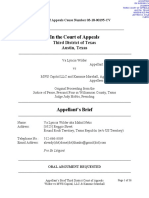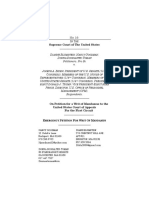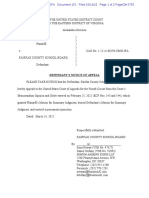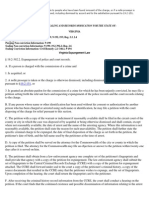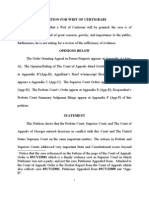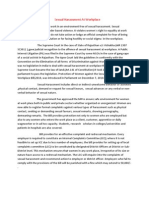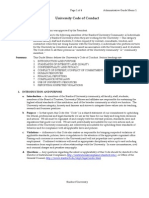Writs of Mandamus & Prohibition PDF
Writs of Mandamus & Prohibition PDF
Uploaded by
Akil BeyCopyright:
Available Formats
Writs of Mandamus & Prohibition PDF
Writs of Mandamus & Prohibition PDF
Uploaded by
Akil BeyOriginal Title
Copyright
Available Formats
Share this document
Did you find this document useful?
Is this content inappropriate?
Copyright:
Available Formats
Writs of Mandamus & Prohibition PDF
Writs of Mandamus & Prohibition PDF
Uploaded by
Akil BeyCopyright:
Available Formats
EXTRAORDINARY WRITS:
WRITS OF MANDAMUS AND WRITS OF PROHIBITION
Extraordinary writs provide an essential alternative to the typical appeal process.
Extraordinary writs allow a court to review an issue that could not adequately be addressed through
the typical appeals process. There are a variety of circumstances where extraordinary writs are
important to battered women due to the urgency and safety concerns of many proceedings involving
battered women. The urgency of these issues combined with a legal system that does not always
respond appropriately to the needs of battered women, make extraordinary writs a valuable resource.
This technical assistance packet explains circumstances when extraordinary writs may be used to get
around the lengthy appeals process when that process will not provide an adequate remedy, explains
the process for obtaining writs of prohibition or writs of mandamus, and includes the statutes, rules
and forms important to petitioning for one of these writs.
Attached: MN 563.01, 586.01-.12; Minn. Rules of Civ. App. Procedure Rules 120, 121; Forms and
detailed procedures for petitioning for writs of mandamus, writs of prohibition, and petitioning for emergency (oral) writs
of mandamus/prohibition.
Originally compiled July 1997
Last Updated May 2001
Battered Womens Legal Advocacy Project, Inc., 2003.
Extraordinary Writs:
Writ of Mandamus and Writ of Prohibition
I.) What Are Extraordinary Writs?
Extraordinary writs fall outside the normal appeal process. For a typical appeal, there must
be a final judgment in the case, or appeal may be allowed for certain pre-judgment court orders.
(Minn. R. Civ. App. P. 103.03). Extraordinary writs allow for a higher court to review a judges
decision or ruling before a final order or judgment has been issued and when the typical appeals
process cannot adequately address the problem. Generally extraordinary writs will most likely be
issued against a lower court, but case law and statute also allow writs to be used against other bodies
that are either compelled by law to fulfill some duty or to prevent them from exceeding their
authority.1
There are four circumstances where either a writ of mandamus or writ of prohibition may be
obtained. These include:
1.) when no adequate remedy at law exists or in other words, the issue cannot be
reviewed meaningfully on appeal from a final order or judgment[;]
2.) when the court is about to exceed its jurisdiction resulting in irreparable
harm[;]
3.) when the trial courts action may effectively decide the case[;] or,
4.) when review of the trial court decision will settle or establish a new rule of
practice affecting other litigants.2
Generally, the primary purpose of extraordinary writs is to allow review by the appellate
courts when an ordinary appeal would be meaningless.3 However, unlike your right to appeal, there
is no right to an extraordinary writ because it is discretionary. In other words, the reviewing court
has discretion in whether to consider the extraordinary writ while, in contrast, it must consider a
proper appeal.
A further restriction for writs of prohibition or mandamus is that the reviewing court
CANNOT control judicial discretion, it can only force the lower court to perform its duties, exercise
its judgment, perform its judicial functions, follow the clear statement of the law, or prevent the
lower court from exceeding its authority or jurisdiction. (Minn. Stat. sec 586.01).
II.) Where do Writs Arise for Battered Women?
1
See Minn. Stat. sec. 586.01 (1996)(enclosed in this packet); Coyle v. City of Delano, 526 N.W.2d 205 (Minn. App.
1995)(compelling the Animal Humane Society to follow its statutory duty to disclose to the public the records of animals
seized); Brandhorst v. Special School Dist. No. 1, 466 N.W.2d 409 (Minn. App. 1991)(stating that mandamus procedure
may be appropriate remedy to compel a required school district procedure.).
2
David F. Herr and Mary R. Vasaly, Appellate Practice In Minnesota: A Decade of Experience with the Court of
Appeals, 19 Wm. Mitchell L. Rev. 613, 628 (1993).
3
Id.
Battered Womens Legal Advocacy Project, Inc., 2003. 1
There are limitless possibilities where extraordinary writs may apply to battered womens
situations, ranging from the OFP context to divorce/custody proceedings. The individual situation
must be closely examined to determine if seeking a writ of mandamus or prohibition would be
appropriate. The appropriate situation to file for an extraordinary writ is when the normal appeal
process would not address the problem adequately.
Some examples of how extraordinary writs may be used by battered women include:
in divorce/custody proceedings, when a family court judge inappropriately orders a family
into mediation when domestic abuse is present, a battered woman could seek a writ of
prohibition to prevent the family court judge from making the inappropriate order to
mediation;
in OFP or harassment restraining order proceedings, when the court or court administrator
inappropriately orders the petitioner to pay filing fees or fees for service of process, the
battered woman could seek a writ of prohibition preventing the court from requiring her to
pay these fees because they are contrary to what the law clearly states or she may seek a writ
of mandamus compelling the court to follow the law which clearly states that petitioners are
exempt from these fees. (See Minn. Stat. sec. 518B.01 subd. 3a).
III.) What is the Difference Between a Writ of Mandamus and a Writ of Prohibition?
The basic distinction between writs of mandamus and writs of prohibition is that the writ of
mandamus compels a judicial body to perform a duty which the law clearly and positively
requires,4 while the writ of prohibition prevents a judicial body from exercising its power in a
manner unauthorized by law.5
A.) Writs of Mandamus
The writ of mandamus commands a lower court to do something that it has neglected to do,
which is clearly a duty required of them. To obtain a writ of mandamus a petitioner must show:
(1) the inferior tribunals failure to fulfill an official duty clearly imposed by law;
(2) a public wrong specifically injurious to petitioner; and
(3) there is no other specific legal remedy.6
For example, a writ of mandamus could be issued to compel a lower court to waive the filing fees for
an OFP petitioner when the court refuses to proceed unless the petitioner pays a filing fee. Minn.
Stat. sec. 518B.01 subd. 3a (1996) clearly states that filing fees for OFPs are waived for all
petitioners, therefore it is the duty of the judicial body handling the OFP to waive the filing fee.
Failure to waive the fee could give rise to a petitioner filing a writ of mandamus to compel the lower
court to follow its duty clearly stated in the law. A writ of mandamus may be an appropriate remedy
because there is no other specific legal remedy for a petitioner who is prevented from obtaining an
OFP because she cannot afford the filing fee.
There are two types of writs of mandamus: peremptory and alternative writs of mandamus.
4
Day v. Wright County, 391 N.W.2d 32 (Minn. App. 1986).
5
State v. Turner, 550 N.W.2d 622, 625 (Minn. 1996).
6
Coyle v. City of Delano, 526 N.W.2d 205, 207 (Minn. App. 1995).
Battered Womens Legal Advocacy Project, Inc., 2003. 2
1.) Peremptory writs of mandamus may be issued [w]hen the right to require the
performance of the act is clear, and it is apparent that no valid excuse for nonperformance
can be given. (Minn. Stat. sec. 586.04 (1996)).
2.) Alternative writs of mandamus allow for the defendant to answer the petition for the
writ of mandamus to show cause why they should not be compelled to comply with the
writ.7
The basic distinction between the two is that with a peremptory writ, there is no valid excuse
for nonperformance of the act clearly required by law, while for an alternative writ of mandamus the
law may be unclear and there may be some valid excuse for not complying.
The important difference is mainly procedural because if the reviewing court decides the writ
is an alternative writ of mandamus, then the body being compelled to comply with the writ
may have an opportunity to answer and show cause why it should not have to comply with the
writ. If the reviewing court finds that the writ is peremptory, then it will not allow the
opposing party to answer and will issue the writ of mandamus because the law so clearly states
the duty required by the opposing party.
B.) Writs of Prohibition
A writ of prohibition is appropriate in the context where a court is ordering something that
falls outside the scope of its jurisdiction or authority. There are three requirements for a writ of
prohibition to be granted:
1.) an inferior court or tribunal must be about to exercise judicial or quasi-judicial power;
2.) the exercise of such power must be unauthorized by law; and
3.) the exercise of such power must result in injury for which there is no adequate remedy.8
The writ of prohibition is used as a preventative, not a corrective measure. In other words the higher
court is preventing or prohibiting the lower court from doing something that it has no authority to do.
An example of when petitioning for a writ of prohibition may be appropriate is if a judge is
exceeding her/his authority by ordering a couple into mediation in a dissolution proceeding when
domestic violence has been found. Since the law clearly states that mediation cannot be ordered for
dissolution when the court has found probable cause that domestic abuse has occurred9 and there is
no available remedy to address the injury to a battered woman caused by ordering her into mediation
with her abuser, the court would be exceeding its authority by ordering mediation.
IV.) Process of Petitioning for Extraordinary Writs
7
Coyle v. City of Delano, 526 N.W.2d 205, 208 (Minn. App. 1995).
8
Minneapolis Star & Tribune Co. v. Schumacher, 392 N.W.2d 197, 208 (Minn. 1986).
9
General Rules of Practice for District Courts Title IV. Rules of Family Court Procedure, Rule 310.01(a) (1996).
Battered Womens Legal Advocacy Project, Inc., 2003. 3
A.) Two Methods: Written or Oral Petitions (forms and procedures for each of these
methods are enclosed in this packet)
There are two methods for petitioning for writs of mandamus or prohibition. The normal
process is by written petition to the court with jurisdiction over issuing the writ. (This method is
governed by Minnesota Rules of Civil Appellate Procedure Rule 120 enclosed in this packet). The
other method is by an emergency mechanism provided in Rule 121 (enclosed) which allows for an
emergency oral petition for extraordinary writs when the procedures of Rule 120 would prevent
the writs from working to achieve their primary purpose10 of granting relief when the ordinary
appeals process would not provide a remedy.
B.) Court Jurisdiction: Where Do You Petition for an Extraordinary Writ?
Generally district courts have original jurisdiction over all cases of mandamus, unless the
writ is to be directed at a district court judge, then the court of appeals has jurisdiction over the
mandamus case. (Minn. Stat. sec. 586.11 (1996)). Since there is no statute for writs of prohibition,
it is unclear whether this same jurisdiction would govern them. Under Rule 120.01, jurisdiction
over extraordinary writs directed toward a lower court, falls with the Minnesota court of appeals.
Jurisdiction over extraordinary writs directed at the court of appeals falls with the Minnesota
supreme court.
C.) Filing Fees
A filing fee of $250 is required to petition for either an oral or written extraordinary writ.
(Minn. R. Civ. App. Pro. Rule 120.04, 121.03). The filing fee is not required if a petition for an oral
writ is denied. To proceed without prepaying these fees, a person may apply to proceed in forma
pauperis which basically allows a person who cannot afford to pay the fees to proceed without
paying. (Minn. Stat. sec. 563.01 governs forma pauperis proceedings and is enclosed). It is not clear
whether fees for writs of mandamus or prohibition would fall under the statute governing proceeding
in forma pauperis.11 However, to prevent denying someone access to these remedies simply because
they cannot afford to pay the filing fees, petitioners for extraordinary writs should be allowed to
proceed in forma pauperis.
D.) Are There Time Limits for Petitioning for an Extraordinary Writ?
Rule 120, governing the procedure for filing extraordinary writs, does not set any time limits
for when to file. The Minnesota supreme court has addressed this issue; their answer was that there
is no specific time limitation for a writ of mandamus and the Rule of Civil Appellate Procedure
(Rule 104.01) governing time limits for appeals is merely a guide for efficiency in the area of writs
of mandamus.12
10
Herr and Vasaly, supra note 2, at 628.
11
State v. Adams, 110 N.W.2d 153 (Minn. 1961)(the issue whether in forma pauperis could be used for writ of
mandamus was never reached because the court denied the petition on other grounds).
12
Johnson v. Minnesota Farm Bureau Marketing Corporation, 232 N.W.2d 200 (Minn. 1975).
Battered Womens Legal Advocacy Project, Inc., 2003. 4
You might also like
- Business Credit Secrets RevealedDocument13 pagesBusiness Credit Secrets RevealedAkil Bey92% (50)
- Civil Orders July 4 2014Document3 pagesCivil Orders July 4 2014Akil Bey100% (16)
- BF & C Info (Bone, Flesh, & Cartilage) Recipe & AnecdotesDocument12 pagesBF & C Info (Bone, Flesh, & Cartilage) Recipe & Anecdotesmickelle100% (1)
- Anti-SLAPP Law Modernized: The Uniform Public Expression Protection ActFrom EverandAnti-SLAPP Law Modernized: The Uniform Public Expression Protection ActNo ratings yet
- McDaniel 10th OpinionDocument45 pagesMcDaniel 10th OpinionAarthi86% (7)
- C.R.C.C.P. Form 2 Complaint Under Simplified Civil Procedure R8-17 PDFDocument1 pageC.R.C.C.P. Form 2 Complaint Under Simplified Civil Procedure R8-17 PDFAntoinette MoederNo ratings yet
- AFFIDAVIT For New Jersey Adult-College Religious ExemptionDocument2 pagesAFFIDAVIT For New Jersey Adult-College Religious ExemptionAkil Bey0% (1)
- Allodial TitleDocument72 pagesAllodial TitlePatrick Sanders89% (27)
- Defendant's Motion For Writ of Body Attachment (Righthaven v. Wayne Hoehn)Document8 pagesDefendant's Motion For Writ of Body Attachment (Righthaven v. Wayne Hoehn)rhvictims100% (1)
- Wilder v. MWS CAPITAL Court of Appeals Appellant Brief (File Stamped)Document36 pagesWilder v. MWS CAPITAL Court of Appeals Appellant Brief (File Stamped)Tonkawa of Texas Nation100% (1)
- Federal Court RemovalDocument181 pagesFederal Court RemovalseanadamNo ratings yet
- Entry of Judgment Nihil Dicit 380 Bueltel EfileServDocument6 pagesEntry of Judgment Nihil Dicit 380 Bueltel EfileServmikekvolpeNo ratings yet
- Post Conviction ReliefDocument5 pagesPost Conviction ReliefAkil Bey100% (1)
- 2.2-Notice of TenderDocument6 pages2.2-Notice of TenderAkil Bey100% (2)
- Petition for Extraordinary Writ Denied Without Opinion– Patent Case 94-1257From EverandPetition for Extraordinary Writ Denied Without Opinion– Patent Case 94-1257No ratings yet
- An Inexplicable Deception: A State Corruption of JusticeFrom EverandAn Inexplicable Deception: A State Corruption of JusticeNo ratings yet
- Petition For Writ of Mandamus Re Maui Planning CommissionDocument70 pagesPetition For Writ of Mandamus Re Maui Planning Commissionscribd.hi.lgns88530% (1)
- Summary Judgement (Final) Summary Judgement (Final)Document17 pagesSummary Judgement (Final) Summary Judgement (Final)Yi YingNo ratings yet
- Anthony Pasquall FARETTA, Petitioner, v. State of CALIFORNIADocument37 pagesAnthony Pasquall FARETTA, Petitioner, v. State of CALIFORNIAScribd Government DocsNo ratings yet
- Cross-Motion For Default JudgmentDocument9 pagesCross-Motion For Default JudgmentSLAVEFATHERNo ratings yet
- Supreme Court Case StudyDocument3 pagesSupreme Court Case StudyJack GillNo ratings yet
- How To Prove Abuse of DiscretionDocument3 pagesHow To Prove Abuse of DiscretionHAMBLETT100% (2)
- Federal Tort Claims Act II PDFDocument58 pagesFederal Tort Claims Act II PDFiamnumber8100% (2)
- Petition For Writ of Mandamus-ACLU vs. CCSDDocument15 pagesPetition For Writ of Mandamus-ACLU vs. CCSDFOX5 VegasNo ratings yet
- Motion - Stay DiscoveryDocument11 pagesMotion - Stay DiscoveryJoel MathisNo ratings yet
- United States Court of Appeals, Eleventh CircuitDocument12 pagesUnited States Court of Appeals, Eleventh CircuitScribd Government DocsNo ratings yet
- Zabavsky DismissalDocument38 pagesZabavsky DismissalMartin AustermuhleNo ratings yet
- Bostic. The Loving v. Virginia, 388 U.S. 1 (1967) Decision Has Been Misapplied by Bostic ToDocument15 pagesBostic. The Loving v. Virginia, 388 U.S. 1 (1967) Decision Has Been Misapplied by Bostic ToEquality Case FilesNo ratings yet
- Motion To Abate Weiss PDFDocument4 pagesMotion To Abate Weiss PDFpalmbeachtimNo ratings yet
- NYSDHR Determination and Order After InvestigationDocument6 pagesNYSDHR Determination and Order After InvestigationThomas PudneyNo ratings yet
- Procedural Due Process (Complete)Document49 pagesProcedural Due Process (Complete)ejusdem generisNo ratings yet
- Blumstein vs. U.S. - Writ of MandamusDocument27 pagesBlumstein vs. U.S. - Writ of MandamusGrant Stern88% (25)
- Choate LienDocument9 pagesChoate LienSpiritually Gifted100% (1)
- The Effect of Ratification As Between The Principal and The Other PartyDocument16 pagesThe Effect of Ratification As Between The Principal and The Other PartyVipul KumarNo ratings yet
- 2020-4-20 Petition For Writ of Certiorari FILEDDocument13 pages2020-4-20 Petition For Writ of Certiorari FILEDCasey FrizzellNo ratings yet
- State's Response To Motion To Dismiss Robert Runcie ChargeDocument8 pagesState's Response To Motion To Dismiss Robert Runcie ChargePeterBurkeNo ratings yet
- APPENDIX H, Petition For Writ of Mandamus FSC 2016-2031Document27 pagesAPPENDIX H, Petition For Writ of Mandamus FSC 2016-2031Neil GillespieNo ratings yet
- Notice of Appeal in The TJ HS Admissions CaseDocument2 pagesNotice of Appeal in The TJ HS Admissions CaseABC7NewsNo ratings yet
- RHB - de - Govt Response To Motion For New Trial - 7-8-24Document11 pagesRHB - de - Govt Response To Motion For New Trial - 7-8-24Susie MooreNo ratings yet
- 10-03-11 Richard Fine Complaint Filed With H Marshall Jarrett, Director, US Attorneys Office, US DOJDocument5 pages10-03-11 Richard Fine Complaint Filed With H Marshall Jarrett, Director, US Attorneys Office, US DOJHuman Rights Alert - NGO (RA)No ratings yet
- Expungement Va LawDocument2 pagesExpungement Va LawJS100% (2)
- Black Diamond SS Corp. v. Robert Stewart & Sons, LTD., 336 U.S. 386 (1949)Document17 pagesBlack Diamond SS Corp. v. Robert Stewart & Sons, LTD., 336 U.S. 386 (1949)Scribd Government DocsNo ratings yet
- Petition For Review - Third Circuit U.S. Court of Appeals Judicial MisconductDocument31 pagesPetition For Review - Third Circuit U.S. Court of Appeals Judicial MisconductEl Aemer100% (2)
- Petition For Cert. Filed in Supreme Court of Georgia Dec. 2009 Stegeman V LilligDocument31 pagesPetition For Cert. Filed in Supreme Court of Georgia Dec. 2009 Stegeman V LilligJanet and JamesNo ratings yet
- Motion For Direct Appeal - #116704Document6 pagesMotion For Direct Appeal - #116704Reboot Illinois100% (1)
- Defendants' Objection To Magistrate's Report and Recommendation Entered February 7, 2012Document5 pagesDefendants' Objection To Magistrate's Report and Recommendation Entered February 7, 2012cinaripat100% (1)
- Mandamus To JudgeDocument12 pagesMandamus To JudgeCurtis Strong100% (1)
- Leo Donofrio - Quo Warranto Legal BriefDocument25 pagesLeo Donofrio - Quo Warranto Legal BriefJohn SutherlandNo ratings yet
- Del. AG Chancery Court Backpage - Com SB 183Document15 pagesDel. AG Chancery Court Backpage - Com SB 183Anonymous OOxUNID8100% (1)
- Notice To Vacate Order of ContemptDocument6 pagesNotice To Vacate Order of Contempttotallynotbleaknarratives100% (2)
- 913 Notice of Removal - FiledDocument71 pages913 Notice of Removal - FiledJeff Wyatt100% (1)
- Hhse Bedrock Response To Motion To VacateDocument16 pagesHhse Bedrock Response To Motion To VacateYTOLeaderNo ratings yet
- Objection To John Fasone Order and Affidavit in SupportDocument51 pagesObjection To John Fasone Order and Affidavit in SupportSLAVEFATHERNo ratings yet
- Judicial NoticeDocument16 pagesJudicial NoticeNihal SahuNo ratings yet
- Motion To Vacate Judgment LawDocument2 pagesMotion To Vacate Judgment Lawdbush2778100% (1)
- State Sovereign Immunity and Tort Liability ChartDocument40 pagesState Sovereign Immunity and Tort Liability ChartBleak NarrativesNo ratings yet
- Mistake of Fact & Mistake of LawDocument5 pagesMistake of Fact & Mistake of LawFrancesco Celestial BritanicoNo ratings yet
- PleadingDocument6 pagesPleadingklg_consultant8688No ratings yet
- PA Rules of Judicial Notice 201Document2 pagesPA Rules of Judicial Notice 2014EqltyMom100% (1)
- 2DCA EFiling Sample Brief Without SAMPLEDocument10 pages2DCA EFiling Sample Brief Without SAMPLEChrisNo ratings yet
- 7 PostConvictionMAR FreeSpeech MiniAppealDocument75 pages7 PostConvictionMAR FreeSpeech MiniAppealN.S. Fuller, Esq.No ratings yet
- Rights of A Child CAT 1Document23 pagesRights of A Child CAT 1Dickson Tk Chuma Jr.No ratings yet
- ReconsiderationDocument6 pagesReconsiderationmmason100% (3)
- Legal ResearchDocument5 pagesLegal ResearchJanileahJudetteInfante100% (1)
- ContemptPacket Cobb CountyDocument11 pagesContemptPacket Cobb CountyWilliam H. Basinger100% (1)
- Petition for Certiorari Denied Without Opinion: Patent Case 98-1151From EverandPetition for Certiorari Denied Without Opinion: Patent Case 98-1151No ratings yet
- James Anthony Traficant, Jr. (Born May 8, 1941) Is A Former DemocraticDocument5 pagesJames Anthony Traficant, Jr. (Born May 8, 1941) Is A Former DemocraticAkil Bey100% (1)
- Case 741 f2d 336 Trezevant V City of TampaDocument8 pagesCase 741 f2d 336 Trezevant V City of TampaAkil Bey100% (2)
- H.J.R. Treaty of VeronaDocument3 pagesH.J.R. Treaty of VeronaAkil Bey100% (1)
- Vital and Applicable United States Codes of LawDocument18 pagesVital and Applicable United States Codes of LawWen' George BeyNo ratings yet
- Notice of Understanding and Intent and Claim of Right - Deregistration of VehicleDocument4 pagesNotice of Understanding and Intent and Claim of Right - Deregistration of VehicleAkil BeyNo ratings yet
- Resolution 1202: Honoring The Moorish - American Society of PhiladelphiaDocument1 pageResolution 1202: Honoring The Moorish - American Society of PhiladelphiaAkil BeyNo ratings yet
- Law and Legal Definitions For Consideration and Study: Great Seal National Association of Moorish AffairsDocument2 pagesLaw and Legal Definitions For Consideration and Study: Great Seal National Association of Moorish AffairsAkil Bey100% (2)
- Foreclosure Court Case FilingDocument7 pagesForeclosure Court Case FilingAkil Bey100% (9)
- Vaccine Contraindication ExemptionDocument1 pageVaccine Contraindication ExemptionAkil BeyNo ratings yet
- Enum RightsDocument24 pagesEnum RightsAkil BeyNo ratings yet
- Clerk of Court and TreasuryDocument2 pagesClerk of Court and TreasuryAkil BeyNo ratings yet
- Adversary ComplaintDocument38 pagesAdversary ComplaintAkil Bey100% (2)
- Why We Are in The Admiralty JurisdictionDocument5 pagesWhy We Are in The Admiralty Jurisdictionsabiont100% (3)
- Beneficiary Trustee Status in Court CasesDocument19 pagesBeneficiary Trustee Status in Court CasesAkil Bey100% (12)
- 91 For AgenciesDocument1 page91 For AgenciesAkil BeyNo ratings yet
- Ownership CasesDocument242 pagesOwnership CasesygkawakamiNo ratings yet
- Reaction and Revolution - The Growth of NationalismDocument14 pagesReaction and Revolution - The Growth of NationalismIsmar HadzicNo ratings yet
- Garcia v. Executive SecretaryDocument2 pagesGarcia v. Executive SecretaryERNIL L BAWANo ratings yet
- Social DifferentiationDocument17 pagesSocial DifferentiationFarah Noreen100% (1)
- Pitt and Mondo Bongo'S Request For Judicial Notice in Support of Demurrer To First Amended Cross-Complaint of NouvelDocument15 pagesPitt and Mondo Bongo'S Request For Judicial Notice in Support of Demurrer To First Amended Cross-Complaint of NouvelHollyRustonNo ratings yet
- Sexual Harassment at WorkplaceDocument2 pagesSexual Harassment at WorkplaceSahil BarhateNo ratings yet
- Stanford SCDocument4 pagesStanford SCDian DorNo ratings yet
- Contoh Agreement LetterDocument5 pagesContoh Agreement LetterHmj Sipil UMNo ratings yet
- Class 12th CD Economics Worksheet 2 PDFDocument2 pagesClass 12th CD Economics Worksheet 2 PDFShinchan ShuklaNo ratings yet
- Physical Security Management (Group Assignment) - Vaisnawi UvanesanDocument3 pagesPhysical Security Management (Group Assignment) - Vaisnawi UvanesanVAISNAWI UVANESANNo ratings yet
- Motion To Quash InformationDocument2 pagesMotion To Quash InformationAnn Alejo-Dela TorreNo ratings yet
- PRESS RELEASE: LilYemen London ConferenceDocument5 pagesPRESS RELEASE: LilYemen London ConferenceLilYemenNo ratings yet
- People v. Manantan, G.R. No. 14129, July 31, 1962Document7 pagesPeople v. Manantan, G.R. No. 14129, July 31, 1962Mary Grace LibatonNo ratings yet
- Guidelines For CommunityDocument10 pagesGuidelines For CommunitymatevargaNo ratings yet
- Spotlight Planet Magazine UpdatedDocument32 pagesSpotlight Planet Magazine UpdatedOlla John IamBezaleel OluwafemiNo ratings yet
- Utility Center, Inc. v. City of Fort Wayne, No. 90S04-1208-PL-450 (Apr. 11, 2013)Document8 pagesUtility Center, Inc. v. City of Fort Wayne, No. 90S04-1208-PL-450 (Apr. 11, 2013)RHTNo ratings yet
- Robert Nozick's Entitlement Theory of Justice in The View of Indian JudiciaryDocument4 pagesRobert Nozick's Entitlement Theory of Justice in The View of Indian Judiciaryakash anand100% (1)
- Hasan MasromDocument58 pagesHasan MasromSyed Azharul Asriq0% (1)
- Hasegawa V Giron DigestDocument2 pagesHasegawa V Giron DigestJien LouNo ratings yet
- Market Analysis and Marketing PlanDocument3 pagesMarket Analysis and Marketing Planabdo adelNo ratings yet
- Special Law VandalismDocument3 pagesSpecial Law VandalismmaechmNo ratings yet
- UC Political-Law PDFDocument99 pagesUC Political-Law PDFJerome VillezaNo ratings yet
- RA 8551-Philippine National Police Reform and Reorganization Act of 1998Document29 pagesRA 8551-Philippine National Police Reform and Reorganization Act of 1998Rocky MarcianoNo ratings yet
- Green Business Plan Business PresentationDocument26 pagesGreen Business Plan Business PresentationKhalied NoynayNo ratings yet
- ISC Class 12 History Question Paper - 2017Document3 pagesISC Class 12 History Question Paper - 2017AVNISH PRAKASHNo ratings yet
- Common Syllabus and Class Rules Special Topics in International Law Ateneo de Manila University Second SemesterDocument4 pagesCommon Syllabus and Class Rules Special Topics in International Law Ateneo de Manila University Second SemesterCo Tam BehNo ratings yet
- Right To Speedy TrialDocument5 pagesRight To Speedy TrialFrancesco Celestial BritanicoNo ratings yet
- Matakovic - Transparency in Funding of Political Parties Croatia 2013Document28 pagesMatakovic - Transparency in Funding of Political Parties Croatia 2013Hrvoje MatakovicNo ratings yet
- Ago vs. CADocument3 pagesAgo vs. CAJan Carlo SanchezNo ratings yet
- That There Has Been Enmity Between The Appellant and Respondent From The Last 10 YearsDocument3 pagesThat There Has Been Enmity Between The Appellant and Respondent From The Last 10 YearsNishu SharmaNo ratings yet









